The Kettlebell upright row is a compound exercise that builds stronger and bigger traps, and rear deltoids (Shoulder).
It is one of the best variations of the dumbbell upright row. Due to the kettlebell’s close grip, it activates more trapezius muscle fibers and comparatively fewer delt muscles compared to a wide-grip barbell upright row.
Also, remember that the close grip puts your tiny infraspinatus and supraspinatus rotator cuffs in a vulnerable position (causing subacromial Impingement).
But you shouldn’t fear integrating the kettlebell upright row into your routine. I will provide the knowledge and skills necessary to perform it safely and effectively.
Want to take your gains to the next level? Discover your daily calorie needs with our free TDEE calculator
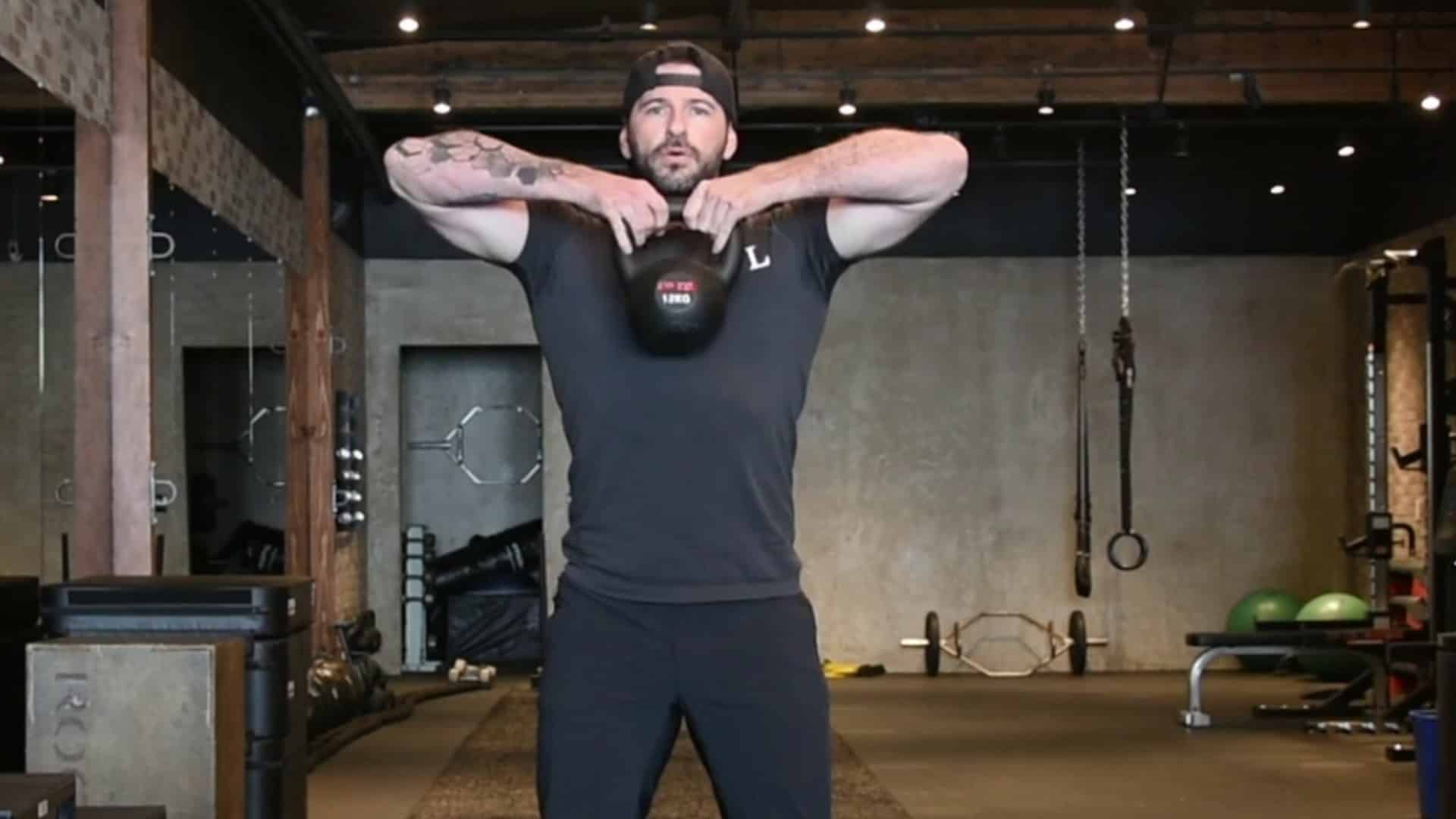
- Kettlebell Upright Row Muscles Worked
- How To Do Kettlebell Upright Row
- Form and Tips
- Best Variation of Kettlebell Upright Row
- 1. One arm kettlebell upright row
- 2. Kettlebell Squat To Upright Row
- Caution When Doing a Kettlebell Upright Row
- Kettlebell Upright Row Alternatives
- 1. Dumbbell Upright Row
- 2. Face Pull
- 3. Wide Grip Barbell Upright Row
- 4. Renegade Row
- References
Kettlebell Upright Row Muscles Worked
- The kettlebell upright row primarily targets the upper back muscles, particularly the deltoids (lateral delt) and the trapezius.
- Secondary muscles engaged during it are the biceps, brachii, and forearm muscles.
- The stabilization muscles used during the Smith machine upright row include the rhomboids, supraspinatus, Infraspinatus, teres minor, serratus anterior, and core muscles.
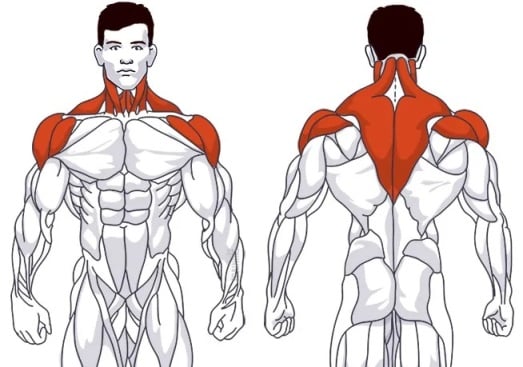
How To Do Kettlebell Upright Row
- You should be standing with your feet shoulder-width apart and bending your knees slightly.
- Place a kettlebell between your legs on the floor.
- Bend down and grasp the kettlebell handle with both hands, using an overhand grip.
- Make sure your palms are facing your body.
- Maintain a neutral spine, engaging your core muscles for stability.
- Pull the kettlebell up towards your chest and keep your elbows close to your body.
- Squeeze your shoulders together as you raise the kettlebell.
- Continue pulling the kettlebell up until it reaches your chest or close to it.
- Keep your elbows slightly higher than your forearms.
- Pause at the movement’s top for a few 2–3 counts.
- Slowly lower the kettlebell back to its starting position.
- Do 8–12 reps and 3–4 sets.
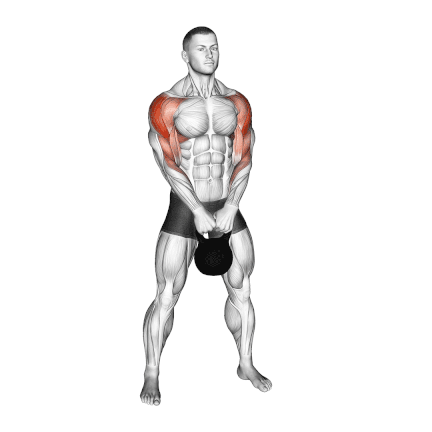
Form and Tips
The kettlebell upright row motion looks simple enough, but getting it wrong could result in disaster (injury) or, at the very least, waste valuable workout time.
This small adjustment improves wrist mechanics, provides better stability, and enhances your overall lifting technique.
- Try to keep your body steady and only move your arms. Keep a controlled motion and avoid jerky movements.
- Start with a lighter weight and gradually increase the weight as your form improves and your confidence grows.
- Don’t slouch or roll your shoulders. Doing so will make the exercise ineffective and could place unnecessary wear and tear on your joints over time.
- As with any lift, keeping a strong and stable core will help to brace and protect the spine.
- Don’t pull the kettlebell too high. Pulling the weight too high can increase the likelihood of a shoulder impingement injury.
- Optimize your grip for kettlebell exercises by avoiding grabbing the top of the handle with both hands. Instead, use the rounded corners at the edge of the handle to widen your grip by a few inches.
- Choose your sets and repetitions based on how well you can move without losing good form.
- Routine for Strength: 3 sets x 12–15 reps
- Routine for Muscle Gains: 4-5 sets x 6–8 reps
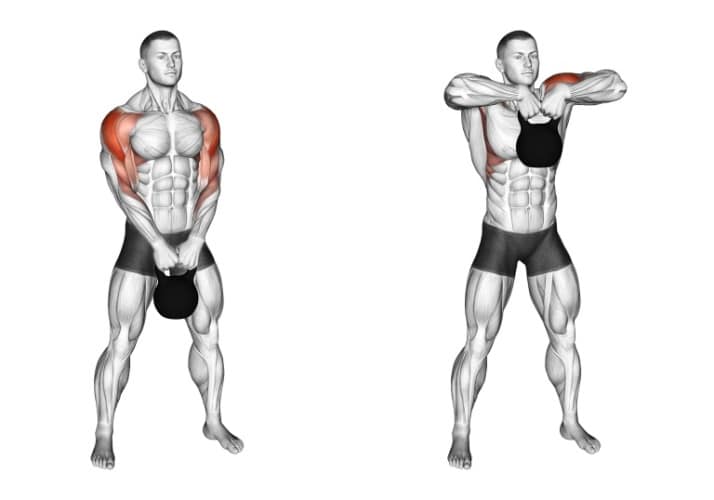
Know More: Best Dumbbell Shoulder Exercises & Workouts For Mass
Best Variation of Kettlebell Upright Row
The variations of the kettlebell upright row are important for several reasons. They target different muscles, stimulate greater muscle growth, prevent plateaus, and cater to specific goals.
You can challenge your upper body muscles in new ways with variations.
1. One arm kettlebell upright row
Single arm upright row is a unilateral variation of the kettlebell upright. It improves the range of motion.
This variation also helps to strengthen your grip and forearm muscles.
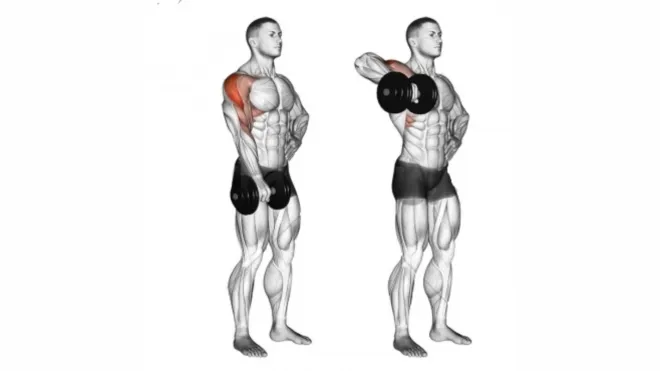
How To Do
- Stand with your feet shoulder-width apart. Hold a kettlebell in your left hand at your side.
- Before you start, tighten your shoulders and hips and squeeze your core.
- Slowly lift the arm toward your chest.
- At the top, pause for a moment and contract the muscles.
- Slowly lower the weight back to the starting position.
- Repeat on the right side after completing all reps on the left side.
2. Kettlebell Squat To Upright Row
The kettlebell squat to upright row combines the lower body squat movement with an upper-body upright row.
It effectively targets the muscles of the legs, glutes, core, upper back, and shoulders, making it a comprehensive full-body exercise.

How To Do
- Hold the kettlebell in front of your thighs with both hands and feet shoulder-width apart.
- Squat down by bending your knees, pushing your hips back, and lifting your chest.
- As you stand up, lift the kettlebell towards your chest, pulling it close to your body in a rowing motion.
- Lower the kettlebell and simultaneously lower your body back into the squat position.
Caution When Doing a Kettlebell Upright Row
The closed grip and internal rotation of the shoulders during the kettle upright row can cause shoulder impingement.
Subacromial impingement occurs when the tendons and bursa in the shoulder become compressed or irritated, leading to pain and limited range of motion. Some people argue that the mechanics of the upright row exercise can contribute to this condition.
It’s important to be mindful of shoulder health and consider alternative exercises or modifications to reduce the risk of subacromial impingement.
Consider alternative exercises that don’t compromise shoulder positioning, such as dumbbell upright row, overhead presses, windmills, clean and presses, or kettlebell swings.
Kettlebell Upright Row Alternatives
Before we deep dive into the best kettlebell upright Row alternatives. We must remember a good kettlebell Upright Row alternative will be able to satisfy the following criteria:
- Activate the deltoid, trap muscle groups, and train them in the upright row.
- Isolate the muscle groups during execution.
- Train the deltoid muscle through a longer range of motion.
1. Dumbbell Upright Row
The dumbbell upright row is a compound exercise that builds stronger and bigger traps and rear deltoids (Shoulder).
It’s a really simple exercise. You hold a dumbbell in each hand and lift them vertically until they’re level with your collarbone before lowering them back down.
2. Face Pull
Face pull is a cable machine exercise that primarily targets the deltoid and traps to a lesser degree and also targets the biceps and triceps.
Use a cable pulley machine to pull the weight straight toward your forehead.
This trap exercise and workout type prevents muscular imbalance and builds overall shoulder strength.
3. Wide Grip Barbell Upright Row
Research shows that the wide grip upright row is one of the best exercises for building shoulder strength and stability.
When done correctly, it is a good exercise for building upper back and shoulder muscles, including trapezius and side delt muscles.
Mastering the barbell upright row can help you with bigger lifts like bench press and deadlifts.
4. Renegade Row
This dynamic exercise targets multiple muscle groups, including the upper back, shoulders, and core, to build strength, stability, and balance.
The Renegade Row is a compound movement involving weights and a plank position to challenge your body in new ways.
Renegade Row can be done with dumbbells, kettlebells, or even a pair of water bottles.
References
- Miniato MA, Anand P, Varacallo M. Anatomy, shoulder and upper limb, shoulder. InStatPearls [Internet] 2021 Jul 31. StatPearls Publishing.
- Graichen H, Bonel H, Stammberger T, et al. A technique for determining the spatial relationship between the rotator cuff and the subacromial space in arm abduction using MRI and 3D image processing. Magn Reson Med. 1998;40(4):640-643. doi:10.1002/mrm.1910400418
- Graichen H, Bonel H, Stammberger T, Englmeier KH, Reiser M, Eckstein F. Subacromial space width changes during abduction and rotation–a 3-D MR imaging study. Surg Radiol Anat. 1999;21(1):59-64. doi:10.1007/BF01635055

Manish is a NASM-certified fitness and nutrition coach with over 10 years of experience in weight lifting and fat loss fitness coaching. He specializes in gym-based training and has a lot of knowledge about exercise, lifting technique, biomechanics, and more.
Through “Fit Life Regime,” he generously shares the insights he’s gained over a decade in the field. His goal is to equip others with the knowledge to start their own fitness journey.
